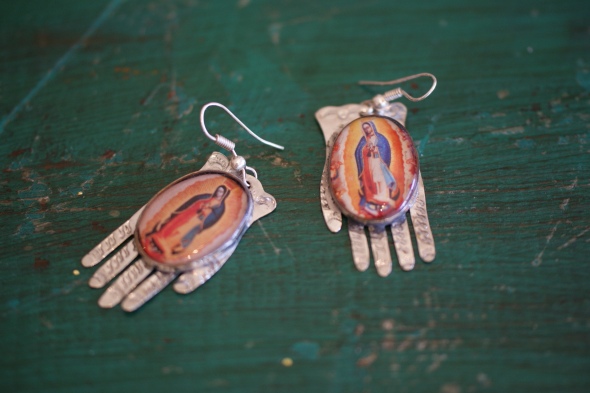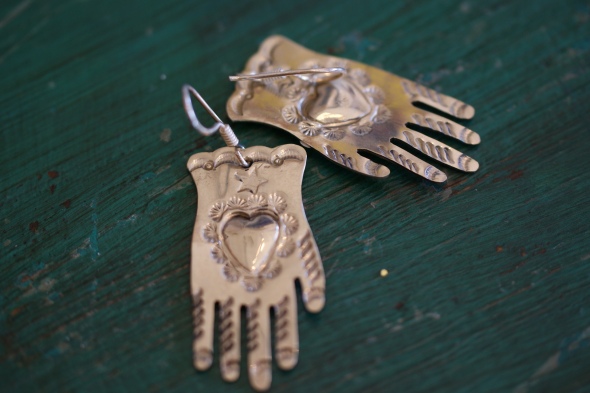Brown Mexican Textiles
Posted: February 22, 2013 Filed under: Chiapas, Folk Art, Global Style, Guatemala, Mexican Crafts, Mexican Folk Art, Mexican Style, Mexican Textiles, Textiles | Tags: handmade, Mexican crafts, Mexican folk art, mexican style, Mexican textiles, table runners, Textiles Comments Off on Brown Mexican TextilesWinston Churchill said many things well. And he commented on many things. But who knew he had an opinion about color? The esteemed Mr. Churchill said, “I cannot pretend to feel impartial about colors. I rejoice with the brilliant ones and am genuinely sorry for the poor browns.”
This post is in honor of the poor browns. They tend to take a back seat to their fellow colors, especially in Mexico. These textiles were discovered at the bottom of the pile, underneath the pinks, roses, reds, yellows, bright oranges and greens. They are a quieter bunch. I do think they have a certain beauty. But they don’t always stand out. They are good listeners. They don’t talk unless they have something to say. They shine when they are on their own. They never compete for attention.
Many of these camino de mesas (table runners) or placemats are woven of a natural brown cotton called “coyuche,” a word that comes from the Nahuatl word for coyote. On the other hand, it is possible that it is white thread dyed to look like coyuche, according to research done by an amazing textile archivist by the name of Karen Elwell. Her many photos of Mexican textiles and clothing are always instructional. Her Flickr photostream is right here.
The photos below are the textiles I currently have in the shop. CLICK on the photograph to take you to the shop. Some are in the online store, but if not, just send me an email on the form at the bottom and I’ll let you know if it’s available!
I couldn’t resist with the last photo. Brilliant color with the poor brown.
Going to the Mercado Merced in Mexico City
Posted: February 10, 2013 Filed under: Mexican Crafts, Mexican Folk Art, Mexican Style, Mexico, Virgin of Guadalupe | Tags: Markets of Mexico, mexican style, Virgin of Guadalupe 2 Comments
One of my favorite things to do wherever I am in Mexico is to visit the local market. In Mexico City, there are so many markets to choose from–all of them slightly different and all of them interesting. Yesterday I took the subway to La Merced, one of the largest mercados in the Federal District. It covers an entire block and then spills out into the streets. I took the photo below to show you how empty the subway station was on an early Saturday morning. The Metro is the best thing going in Mexico City. It costs 3 pesos to go anywhere and it’s clean, safe and speedy.

The Metro stops right inside the market so there’s no confusion about where to get off. Just climb up the stairs from the train and boom, you are inside the huge Mercado Merced. I like to wander a bit just looking at the fruits and vegetables, the zapatos, the plastic stuff, but my ultimate destination is always the paper products. There is such a huge variety in so many colors! Valentine’s Day is coming soon, so there’s an abundance of pink and red.

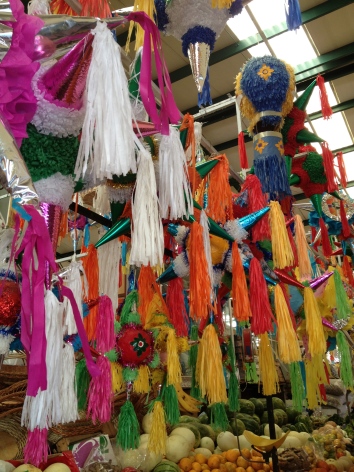
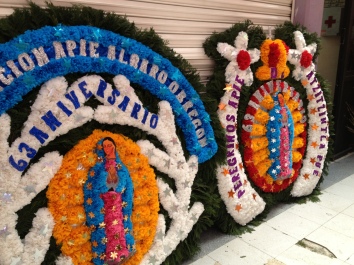
These decorations look like they are decorated with flowers but it’s paper!
Zinnia Mexican Folk Arts Shop
Posted: January 11, 2013 Filed under: Folk Art, Mexican Crafts, Mexican Folk Art, Mexican Style, Unique gifts & Jewelry, Zinnia Folk Arts Shop | Tags: Day of the Dead, Folk Art, handmade, Heron Martinez, Mexican ceramics, Mexican crafts, Mexican folk art, mexican style, Textiles Comments Off on Zinnia Mexican Folk Arts ShopI thought you might be interested in the most recent look at how we like to display Mexican folk art at Zinnia Folk Arts shop! We wanted to move the holiday decorations out so I decided to put the vintage (1960’s White Period) Heron Martinez tree of life in the front window and build a colorful support cast of a variety of Mexican crafts. The color is so welcome during these grey days in Minnesota…it’s actually raining today. Enjoy the photos and of course, if you’re in Minneapolis, stop in. We’ll be waiting for you. Saludos!
More Mexican Folk Art Wood Carvings from Oaxaca
Posted: January 10, 2013 Filed under: Folk Art, Masks, Mexican Style, Oaxaca, Wood Carvings | Tags: Folk Art, handmade, Mexican crafts, Mexican folk art, Oaxaca, Wood Carvings Comments Off on More Mexican Folk Art Wood Carvings from OaxacaOne of the popular arts for which Mexico is most famous is the wood carvings of Oaxaca. In fact, if people only know one thing about folk art from Mexico, it’s usually about the wood carvings or “alebrijes” which they’ve seen at the beach resorts or airports of coastal Mexico.
The carving of masks and children’s toys in the Oaxaca area dates back hundreds, if not thousands of years, but the current expression of wood carvers in Oaxaca’s surrounding villages was started in the small town of Arrazola by Manuel Jiménez in the late 1950’s. Now, three tiny villages –Arrazola, San Martin Tilcajete, and La Union–are known for their carvings and carvers. The lives of these artisans are not easy. Oaxaca is one of the poorest states in Mexico and most of the carvers living in these villages are subsistence farmers and carve their beautiful pieces for extra income.
A few carvers have done exceedingly well and are world-renowned. This is true for Jacobo Angeles whose amazing work can take months to complete. He employs many, many family members in his lovely home in San Martin Tilcajete. His taste and ability are exquisite and his carvings are highly regarded and highly sought after. We carry the beautiful carved hummingbirds as seen below:
Jacobo’s sister, Roberta, carved this stunning nativity set and it too is exceptional in its concept and execution. Truly a unique and collectible piece.
There are many, many very skilled carvers in Oaxaca and I wish I could feature all of them. I plan to feature others in the days ahead.
Today, I want to recommend a couple of carving families in addition to the familia Angeles, and those are first, Flor and Abad Xuana and second, Aurelia and Juventino Melchor. In both of these families, the man does the carving and the woman does the painting. And in both cases, each person is an artist extraordinaire!
I’ve carried the carvings of the Xuanas before and they will always be some of my favorites. Flor is one of the tiniest people I’ve ever met and one of the most lovely. This photo was taken at the Day of the Dead show in Oaxaca.
Here are some of the lovely pieces that I purchased from Flor and are now available at Zinnia Folk Arts.
The duck, white bird and woodpecker are exceptionally beautiful. You can click on the photos for more info and details.
There is another couple from San Martin Tilcajete who does very nice work. They are named, Juventino and Aurelia Melchor. I especially fell in love with their bunnies and have quite a few of them in the shop. Here are two in the website shop…
For more information about Oaxacan wood carving and carvers as well as the inevitable politics of it all, you can read, Oaxacan Woodcarving by Shepard Barbash (1993). Another writer is Michael Chibnick and his book is Crafting Tradition: The Making and Marketing of Oaxacan Wood Carvings.
As always, if you have any questions, please ask!
Custom Made Pinatas
Posted: December 17, 2012 Filed under: Folk Art, Mexican Crafts, Mexican Holidays, Mexican Style, Paper Mache, Pinatas, Unique gifts & Jewelry, Zinnia Folk Arts Shop | Tags: Celebrate the holidays, handmade, Mexican crafts, Mexican folk art, Mexican holidays, mexican style, paper folk art, paper mache, Pinatas Comments Off on Custom Made PinatasThis is the season for pinatas in Mexico. Big ones, small ones. The pinata maker in town will make lots of different ones to be purchased by families who will host the procession of visitors who go door to door looking for shelter–just like Mary and Joseph did so many thousands of years ago. The “Posadas” started yesterday, December 16th and will proceed every night until December 24th. The party at the last house will include the pinata game for children (and some adults). The pinatas traditionally have a clay pot in the center and then paper mache surrounding the pot and the star points. They come in lots of colors and sizes and designs and they are always a treat to see. Most public spaces will feature giant pinatas as decorations and they are especially gorgeous.
I have been embellishing pinatas since I started Zinnia Folk Arts several years ago and have several in the front of the store that I use for decoration. Over the years people have asked me to make them for their parties, bridal showers or weddings. This very pink pinata in the after photo is going to decorate a very sweet young girl’s room. I thought you’d be interested in seeing the before picture and the after. It used to be a Minnie Mouse pinata and now is a pink and green confection. Enjoy!
Here’s the before:
And here’s the after!
The Virgin of Guadalupe and Mexican Folk Art
Posted: December 12, 2012 Filed under: Mexican Crafts, Mexican Folk Art, Mexican Holidays, Mexican Style, Religious Folk Art, Unique gifts & Jewelry, Virgin of Guadalupe | Tags: basilica of guadalupe, handmade, Mexican crafts, Mexican folk art, Mexican holidays, mexican style, Religious folk art, Santos, Virgin of Guadalupe Comments Off on The Virgin of Guadalupe and Mexican Folk ArtIn Mexico, December 12 is the Fiesta of la Virgen de Guadalupe. Pilgrims from all over Mexico walk, ride buses, drive, ride bikes and even walk on their knees to arrive at the Basilica of Guadalupe that was built on the hill where Juan Diego saw the Virgin three times in the 1500’s. The tilma that was seen by Juan Diego is preserved in the Basilica and many, many people make pilgrimages to see it and to pray for help of all kinds. But it’s not just in Mexico City that people remember and celebrate her today–it’s everywhere in the country.
Guadalupe is a world-famous icon of the Virgin Mary. She is fondly known as the “Queen of Mexico.” Her image can be found everywhere in Mexico. She’s recognizable by the golden rays that surround her image and by the little cherub at her feet.
Here’s a photo of the original Basilica de Guadalupe in Mexico City.

Yes, it’s sinking! That’s partly why a new Basilica was built to the left of this photo. I like the old one better.
Light a candle and leave it outside one of several chapels on the Tepeyac Hill.
We carry 5″ tall Lux Candles. Take off the tissue paper and the lid, light it and wait for the image to be illuminated by the flame (it will take a while).
Folk artists use her image in every imaginable way and express their love and admiration for her through their media.
This is the Virgen de Guadalupe according to the Purepecha people of Michoacan. The whimsical Guadalupe wall plaque was made in Ocumicho.
Wooden bateas (carved trays) painted with the Virgin’s image come from Michoacan. These are decorative and are meant to be hung on the wall or set in a holder for display.
This is a reverse glass painting of la Virgen. The technique is an old-fashioned one but is being revived by a Mexico City artist, Manuel Bauman.
This is a large and lovely retablo with many saints on wood and painted in Michoacan. Available in the shop or by email!
This gorgeous tin cross decorated on the inside with Guadalupe and the symbolic roses comes from Oaxaca. Available in the shop or by email!
Nickel Silver earrings with the image of the Virgin available here.
And of course decorative boxes! These are especially lovely and very unique. They are from Mexico City. Available in the shop or by email.
A Shiny and Glittery Mexican Folk Art Christmas
Posted: December 3, 2012 Filed under: Christmas, Folk Art, Mexican Crafts, Mexican Folk Art, Mexican Holidays, Mexican Style, Navidad, Religious Folk Art | Tags: Celebrate the holidays, Christmas, handmade, Mexican crafts, Mexican folk art, Mexican holidays, Navidad, Virgin of Guadalupe Comments Off on A Shiny and Glittery Mexican Folk Art ChristmasHere are a few examples of Mexican folk art in the shop for the Navidad season. There are lots of unique pieces–teeny little glittered Virgin of Guadelupe ($12) the beautiful large, Oaxacan, painted wall ornaments ($45), unpainted tin lumenaria in two sizes ($15 and $20), lovely tin pop-up nativity scenes inside a narrow box ($36), tiny little nacimiento boxes from Puebla ($18) and an amazing clay advent wreath from Izucar de Matamoros ($145).
None of these things are on the website but any of them can be purchased. Just let me know if you would like something. We ship all over the world!
Remembering the Dead Publicly during Dias de los Muertos
Posted: November 1, 2012 Filed under: Day of the Dead, Mexican Folk Art, Mexican Holidays, Mexican Style, Mexico | Tags: cockscomb, Day of the Dead, marigolds, Mexican folk art, Mexican holidays, mexican style Comments Off on Remembering the Dead Publicly during Dias de los Muertos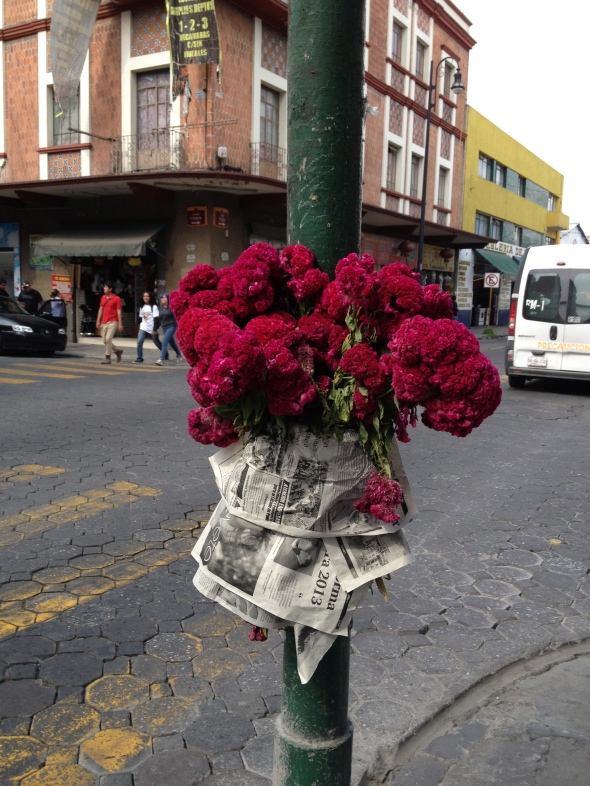
Public installations of folk art take many forms in Mexico. As I’ve said before, folk art is handmade, it is regional, it’s made of material available in one’s community, the methods are passed down from generation to generation and it expresses a community belief or value.
Here a simple bouquet of cockscomb attached to a traffic light in the middle of downtown Puebla not only provides passersby with a dab of beauty, but reminds everyone who passes, that a life was taken at this location. Someone died here. It raises our awareness that death is out there. In Mexico, death is not shoved into the back room. Death is a part of life and the Days of the Dead are a time to remember, both privately and publicly, those loved ones who have died.
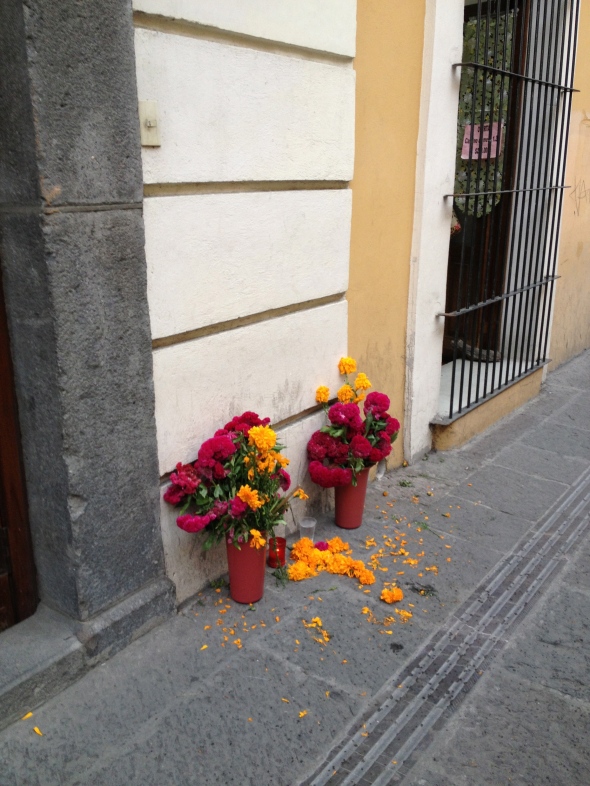
Someone else died here.
One sees bouquets and shrines built along the roads and highways of Mexico all year long. But during these special days of November 1 and 2, spontaneous eruptions of bouquets of marigolds and cockscomb appear in the cities and pueblos, reminding all of us that we are a mortal people and that life goes on after death.
Mexican Folk Art Plates from Delores Hidalgo, Mexico
Posted: September 20, 2012 Filed under: Clay Ceramics, Mexican Folk Art, Mexican Pottery, Mexican Style, Talavera, Unique gifts & Jewelry | Tags: Ceramics, handmade, Mexican ceramics, Mexican crafts, Mexican folk art, mexican style, talavera Comments Off on Mexican Folk Art Plates from Delores Hidalgo, Mexico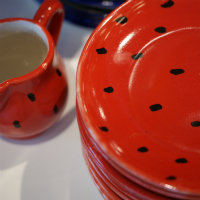

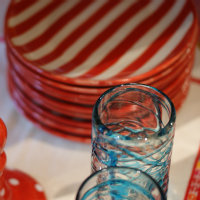
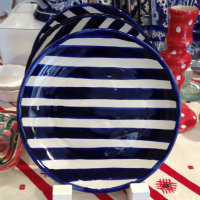
Summer is winding down in Minnesota, but if you aren’t quite ready to let it go (or you live in a warm weather climate all year-long–lucky you) take a look at this handmade Mexican folk art from the town of Delores Hidalgo. These cheerful Mexican crafts are made individually the old-fashioned way. Yes, on a wheel and then glazed and fired. They are safe for eating (no lead) and can go into the microwave and dishwasher. These somewhat low fired ceramics can chip so it’s a good idea to treat them with respect. (No juggling.)
Almost every region of Mexico makes objects out of clay. In the state of Guanajuato, Delores Hidalgo is known for making “talavera.” There are hundreds of shops selling a wide range of ceramics in varying levels of quality. Talavera is a style of ceramic work that was brought to Mexico by the Spaniards after the conquest in the 1500’s. The other city that is perhaps even more well-known for talavera and is home to many masters of the craft, is Puebla in the state of Puebla. Puebla is home to one of the best, Uriarte. The styles of the talavera in the two cities are somewhat different with Puebla being even more Spanish in tradition. Another offshoot of these functional Mexican crafts is “majolica” and that can be found principally in the city of Guanajuato. Gorky Gonzalez is one of the famous potters of Guanajuato and many people recognize the Gorky style immediately. Another well-known majolica artisan in the city of Guanajuato is Capelo.
The functional Mexican folk art ceramics of Mexico are beautiful and we carry a lot of them in the shop at Zinnia Folk Arts. Stop in to our Twin Cities store or take a look right here!


